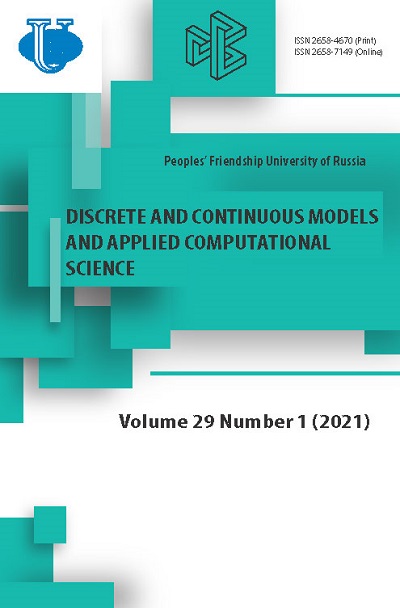Normal modes of a waveguide as eigenvectors of a self-adjoint operator pencil
- Authors: Malykh M.D.1
-
Affiliations:
- Peoples’ Friendship University of Russia (RUDN University)
- Issue: Vol 29, No 1 (2021)
- Pages: 14-21
- Section: Articles
- URL: https://journals.rudn.ru/miph/article/view/26137
- DOI: https://doi.org/10.22363/2658-4670-2021-29-1-14-21
Cite item
Full Text
Abstract
A waveguide with a constant, simply connected section is considered under the condition that the substance filling the waveguide is characterized by permittivity and permeability that vary smoothly over the section , but are constant along the waveguide axis. Ideal conductivity conditions are assumed on the walls of the waveguide. On the basis of the previously found representation of the electromagnetic field in such a waveguide using 4 scalar functions, namely, two electric and two magnetic potentials, Maxwell’s equations are rewritten with respect to the potentials and longitudinal components of the field. It appears possible to exclude potentials from this system and arrive at a pair of integro-differential equations for longitudinal components alone that split into two uncoupled wave equations in the optically homogeneous case. In an optically inhomogeneous case, this approach reduces the problem of finding the normal modes of a waveguide to studying the spectrum of a quadratic self-adjoint operator pencil.
Full Text
Introduction Consider a waveguide representing a cylinder of constant cross-section
About the authors
Mikhail D. Malykh
Peoples’ Friendship University of Russia (RUDN University)
Author for correspondence.
Email: malykh_md@pfur.ru
Doctor of Physical and Mathematical Sciences, Assistant Professor of Department of Applied Probability and Informatics
6, Miklukho-Maklaya St., Moscow, 117198, Russian FederationReferences
- A. G. Sveshnikov and I. E. Mogilevsky, Mathematical problems in the theory of diffraction [Matematicheskiye zadachi teorii difraktsii]. Moscow: MSU, 2010, in Russian.
- K. Zhang and D. Li, Electromagnetic theory for microwaves and optoelectronics, 2nd ed. Berlin: Springer, 2008.
- A. N. Bogolyubov, A. L. Delitsyn, and A. G. Sveshnikov, “On the completeness of the set of eigen- and associated functions of a waveguide,” Computational Mathematics and Mathematical Physics, vol. 38, no. 11, pp. 1815-1823, 1998.
- A. N. Bogolyubov, A. L. Delitsyn, and M. D. Malykh, “On the root vectors of a cylindrical waveguide,” Computational Mathematics and Mathematical Physics, vol. 41, no. 1, pp. 121-124, 2001.
- A. L. Delitsyn, “On the completeness of the system of eigenvectors of electromagnetic waveguides,” Computational Mathematics and Mathematical Physics, vol. 51, pp. 1771-1776, 2011. DOI: 10. 1134 / S0965542511100058.
- W. C. Chew. “Lectures on theory of microwave and optical waveguides.” (2012), [Online]. Available: http://wcchew.ece.illinois.edu/chew/ course/tgwAll20121211.pdf.
- N. A. Novoselova, S. B. Raevskii, and A. A. Titarenko, “Calculation of characteristics of symmetric modes propagating in a circular waveguide with radially-heterogeneous dielectric filling [Raschet kharakteristik rasprostraneniya simmetrichnykh voln kruglogo volnovoda s radial’no-neodnorodnym dielektricheskim zapolneniyem],” Trudy Nizhegorodskogo gosudarstvennogo tekhnicheskogo universiteta im. R.Ye. Alekseyeva, no. 2(81), pp. 30-38, 2010, in Russian.
- A. L. Delitsyn and S. I. Kruglov, “Mixed finite elements used to analyze the real and complex modes of cylindrical waveguides,” Moscow University Physics Bulletin, vol. 66, pp. 546-560, 2011. DOI: 10.3103/ S0027134911060063.
- A. L. Delitsyn and S. I. Kruglov, “Application of the mixed finite element method for calculating the modes of cylindrical waveguides with a variable refractive index [Primeneniye metoda smeshannykh konechnykh elementov dlya vychisleniya mod tsilindricheskikh volnovodov s peremennym pokazatelem prelomleniya],” Zhurnal radioelektroniki, no. 4, pp. 1-28, 2012, in Russian.
- F. Hecht, Freefem++, 3rd ed., Laboratoire Jacques-Louis Lions, Universitè Pierre et Marie Curie, Paris, 2018.
- M. D. Malykh, N. E. Nikolaev, L. A. Sevastianov, and A. A. Tiutiunnik, “On the representation of electromagnetic fields in closed waveguides using four scalar potentials,” Journal of Electromagnetic Waves and Applications, vol. 32, no. 7, pp. 886-898, 2018. doi: 10.1080/09205071. 2017.1409137.
- M. D. Malykh and L. A. Sevast’yanov, “On the representation of electromagnetic fields in discontinuously filled closed waveguides by means of continuous potentials,” Computational Mathematics and Mathematical Physics, vol. 59, pp. 330-342, 2019. doi: 10.1134/S0965542519020118.
- I. C. Gohberg and M. G. Krein, Introduction to the Theory of Linear Non-selfadjoint Operators in Hilbert Space. American Mathematical Society, 1969.
















